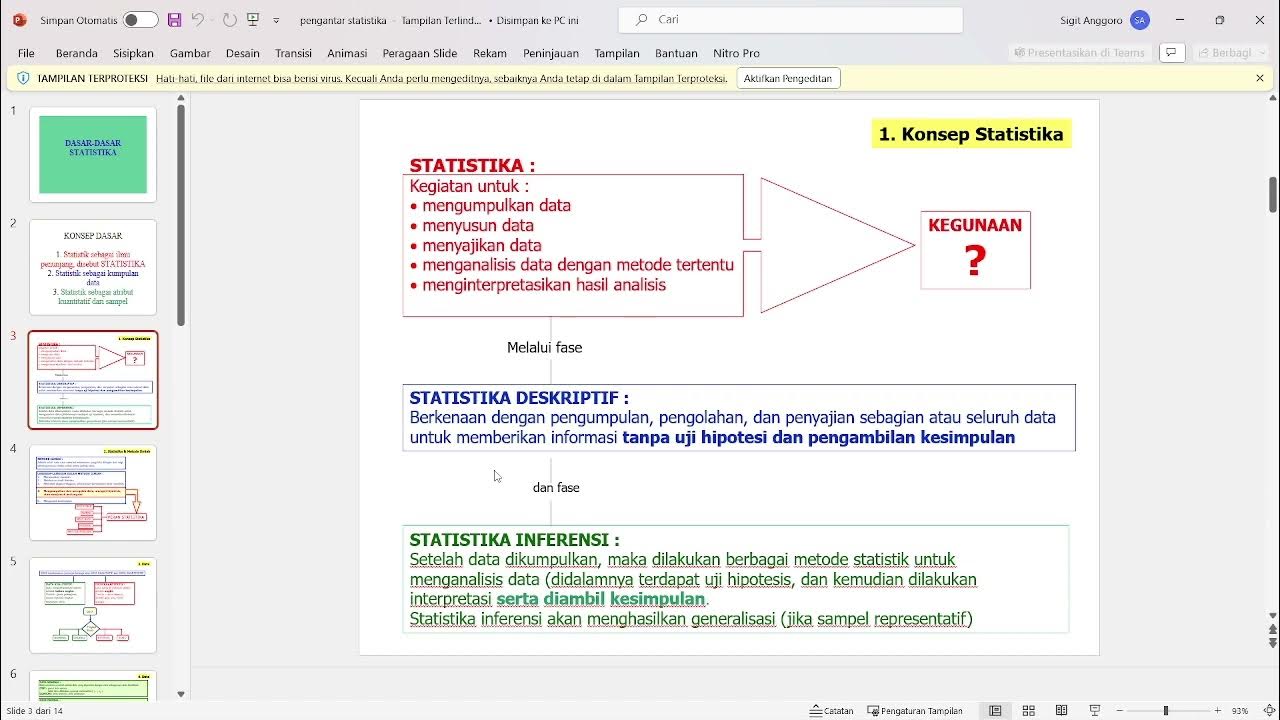Statistik 2: pembagian statistika
Summary
TLDRThis educational transcript introduces key concepts in statistics, distinguishing between theoretical and applied statistics. It explains the importance of a strong mathematical foundation for theoretical statistics, which focuses on formulas and models. In contrast, applied statistics is centered around practical methods and tools, such as SPSS, that can be used in real-world research. The lecture also covers the roles of descriptive statistics, which summarize and present data, and inferential statistics, which draw conclusions about a larger population based on sample data. Both areas are crucial for making valid and useful research conclusions.
Takeaways
- 😀 The script divides statistics into two main categories: theoretical statistics and applied statistics.
- 😀 Theoretical statistics involves deep mathematical concepts, including formulas, properties, and theoretical models.
- 😀 Applied statistics focuses on practical methods and tools used to analyze real-world data, such as SPSS.
- 😀 In applied statistics, the primary concern is the use of statistical methods rather than the derivation of formulas.
- 😀 Descriptive statistics is about summarizing and presenting data in clear forms like tables, graphs, and charts.
- 😀 Descriptive statistics provides a foundation for inferential statistics by describing the characteristics of data.
- 😀 Inferential statistics is used to make generalizations or conclusions from a sample to a larger population.
- 😀 Inferential statistics requires the accurate use of descriptive statistics to draw valid conclusions.
- 😀 In statistical research, the ultimate goal is to reach conclusions, which is achieved through inferential statistics.
- 😀 While theoretical statistics requires a strong mathematical background, applied statistics is more focused on the usability of statistical methods in various fields like social sciences.
Q & A
What is the difference between theoretical and applied statistics?
-Theoretical statistics focuses on the mathematical foundations and formula derivations, requiring a strong mathematical background. Applied statistics, on the other hand, is more practical and focuses on using statistical methods to solve real-world problems, often using tools like SPSS.
Why is applied statistics emphasized in this session?
-Applied statistics is emphasized because the audience comes from a social science background, not a technical or mathematical one, making it more relevant to their needs and expertise.
What does descriptive statistics aim to achieve?
-Descriptive statistics aims to summarize and present data in a clear and understandable format, such as tables, graphs, and charts, providing a basic overview of the dataset.
How does descriptive statistics contribute to inferential statistics?
-Descriptive statistics provides the foundational understanding of the data, which is necessary for making valid inferences in inferential statistics. Without accurate descriptions of the sample, inferential statistics could lead to incorrect conclusions.
What role does mathematics play in theoretical statistics?
-Mathematics plays a central role in theoretical statistics, as it is used to formulate models, derive formulas, and establish the properties of statistical methods. A deep understanding of mathematical concepts is required.
What is the focus of inferential statistics?
-Inferential statistics focuses on drawing conclusions from sample data and generalizing those conclusions to larger populations. It involves making inferences and predictions based on statistical evidence.
How does SPSS fit into applied statistics?
-SPSS is a tool commonly used in applied statistics to perform data analysis and apply statistical methods. It allows users to carry out statistical procedures efficiently without needing to manually compute complex formulas.
What is the main objective of learning applied statistics in this context?
-The main objective is to learn how to use statistical methods effectively to analyze data in various fields, particularly focusing on practical applications rather than theoretical derivations.
What does 'inferential statistics' mean in the context of this explanation?
-In this context, inferential statistics refers to the process of drawing conclusions or making generalizations from a sample of data, allowing researchers to apply findings to a broader population.
Why is it important to understand both descriptive and inferential statistics?
-Understanding both descriptive and inferential statistics is important because descriptive statistics helps to organize and summarize the data, while inferential statistics allows researchers to draw conclusions and make predictions about a larger population from the sample data.
Outlines

This section is available to paid users only. Please upgrade to access this part.
Upgrade NowMindmap

This section is available to paid users only. Please upgrade to access this part.
Upgrade NowKeywords

This section is available to paid users only. Please upgrade to access this part.
Upgrade NowHighlights

This section is available to paid users only. Please upgrade to access this part.
Upgrade NowTranscripts

This section is available to paid users only. Please upgrade to access this part.
Upgrade NowBrowse More Related Video
5.0 / 5 (0 votes)





